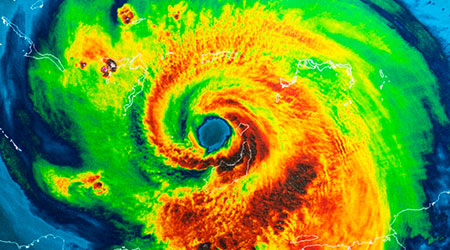Preparing for a natural disaster such as a hurricane is critical to ensure people are safe, assets are protected and business can resume. Having a formal process to prepare will provide any organization a consistent formula for success in the event a hurricane was to impact their operations.
Unlike many other natural disasters, hurricanes are often predictable when estimating strength and path. Mitigating the risk of a hurricane’s impact requires planning, organization, guidance and teamwork. Whether at a healthcare facility or office building, the ability to maintain core business functions during a crisis is essential.
It is no secret that hurricanes are often dangerous and life-threatening events. Hurricanes typically start life as a tropical depression or storm, ultimately increasing in strength and size. Some hurricanes form quicker than others, oftentimes catching organizations by surprise.
It is essential to understand when and where hurricanes are likely to impact areas of interest. According to the National Hurricane Center and the Central Pacific Hurricane Center, “the Atlantic hurricane season runs from June 1st to November 30th, and the Eastern Pacific hurricane season runs from May 15th to November 30th. The Atlantic basin includes the Atlantic Ocean, the Caribbean Sea and Gulf of Mexico. The Eastern Pacific basin extends to 140°W.”
The fundamental steps which are vital to an organization’s hurricane preparedness plan consist of:
- Outline of responsibilities
- Preparedness practices
- Contact lists and directories
- Continuous communication and updates
- Recovery activities
- Post-incident management
Outline of responsibilities:
Make expected action clear. What good is any plan if those who drive it don’t understand it to take proper action? Whether it is the Safety team, Operations, Human Resources or Communications, each role must have defined responsibilities.
Preparation practices:
The entire reason to have a plan is to be proactive. A reactive approach will nearly always leave you in a worse place than you were in before. By organizing the preparation practices necessary to combat a hurricane, you give your organization and your customers a proactive solution to potential threats.
Contact lists and directories:
Knowing where your employees are at all times during a natural disaster is crucial. Knowing how to contact them is just as important. Having the ability to do the same for your customers shows your level of preparation and your level of care.
Continuous communication and updates:
During the life cycle of a hurricane, people need to know the status and what they need to do. Proper communications which detail the hurricane activity, strength, path and impact allow employees and customers to take the right course of action at the right moment. Preparation is dependent on strong communication.
Recovery activities:
During recovery activities, you will want to check on team members’ status, assess the damage, distribute equipment, labor, and supplies. Now is when a full analysis of the recent events becomes clear. What has occurred, and to what level? Most importantly, what can you do to help?
Post-incident management:
Understanding your organization’s policies and procedures for documenting post-incident events and property/assets damage is an important step in the post-incident management process. You will want to assess the circumstances and investigate them appropriately.
How can you prepare for the next hurricane?
Prepare a formal plan which anticipates the minimal and severe impacts a hurricane can bring. Ensure all employees within your organization understand the preparedness plan and encourage employee involvement throughout the process. Understand local emergency services and know their contact information. Having current employee and customer contact information is necessary for ensuring all involved parties are in safe hands.
Matthew Hitchcock is the Senior Manager of EH&S for ABM Business & Industry and for Healthcare services.

 UF Health Hospitals Rely on Green Globes to Realize Their Full Potential
UF Health Hospitals Rely on Green Globes to Realize Their Full Potential How Healthcare Facilities Can Be Truly Disaster-Resilient
How Healthcare Facilities Can Be Truly Disaster-Resilient TriasMD Breaks Ground on DISC Surgery Center for San Fernando Valley
TriasMD Breaks Ground on DISC Surgery Center for San Fernando Valley Bigfork Valley Hospital Falls Victim to Data Breach
Bigfork Valley Hospital Falls Victim to Data Breach AI-Driven Facilities: Strategic Planning and Cost Management
AI-Driven Facilities: Strategic Planning and Cost Management